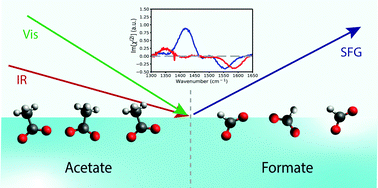Molecular orientation of small carboxylates at the water–air interface†
Abstract
We study the properties of formate (HCOO−) and acetate (CH3COO−) ions at the surface of water using heterodyne-detected vibrational sum-frequency generation (HD-VSFG) spectroscopy. For both ions we observe a response of the symmetric (νs) and antisymmetric (νas) vibrations of the carboxylate group. The spectra further show that for both formate and acetate the carboxylate group is oriented toward the bulk, with a higher degree of orientation for acetate than for formate. We found that increasing the formate and acetate bulk concentrations up to 4.5 m does not change the orientation of the formate and acetate ions at the surface and does not lead to saturation of the surface density of ions.



 Please wait while we load your content...
Please wait while we load your content...